Lipophenol®
World first! Highly Permeable Oil-soluble Polyphenol
~ Lipophenol® ~
Ingredient for cosmetic OEM2019.08.21
“Lipo” is a lipid. “Phenol” is a polyphenol.
In other words, “Lipophenol” is an oil-soluble polyphenol obtained from plants, and it is a rare component that can only be obtained from dozens of sweet potatoes to 1 gram.
Lipophenol is an expected natural ingredient that combines various functions* and high skin permeability. Lipophenol will solve many skin problems*
*Functionality: anti-pigmentation, anti-inflammatory, anti-photoaging, anti-glycation, anti-aging, etc.
*Skin troubles: spots, dryness, pores, wrinkles, needles, dullness, acne, etc.

-
1. Excellent transepidermal absorbability of Lipophenol
-
2. Lipophenol structure and expected anti-melanogenic effect
-
3. Origin of Lipophenol is priming sweet potato
-
4. Priming sweet potato significantly improves antioxidant properties
-
5. Efficacy information
-
6. Anti-melanogenic effect of Lipophenol (B16 melanoma cell)
-
7. Anti-inflammatory effect of Lipophenol (Keratinocyte)
-
8. Antioxidant properties of Lipophenol
-
9. Hyaluronan production activation effect of lipophenols
-
10. Lipophenol has multiple action points in anti-melanogenesis (summary)
-
11. World’s first plant ingredient invented by cosmetic OEM company
-
12. Product information
Table of contents
1. Excellent transepidermal absorbability of Lipophenol
The cell membrane of about 37 trillion cells that make up the human body1) is made up of lipids. Therefore, oil-soluble Lipophenol is excellent for percutaneous absorption and penetrates cells to exert high physiological functions.
1) E. Bianconi, et al., Ann. Hum. Biol., 40, 463-71 (2013),
An estimation of the number of cells in the human body.

植物リポフェノールの細胞膜透過性と経皮吸収性
2. Lipophenol structure and anti-melanogenic effect
The sweet potatoes cork the tuberous peripheries to protect it from drying to keep offspring. At this time, a new caffeic acid alkyl ester with increased oil solubility by combining cetanol with polyphenol is created in the tuberous root to prevent moisture transpiration of sweet potatoes. Cork layers are also known to protect tissues from ultraviolet radiation.
* Caffeic acid: Has long experience of eating because it is contained a lot in coffee.
It is known that it has a strong antioxidative property because it has a catechol structure.
Caffeic acid, which constitutes plant Lipophenol, is known to cause antagonistic inhibition to tyrosinase, because it is similar in structure to tyrosine and easily binds to the hydrophobic active site of tyrosinase. In addition, plant Lipophenol has excellent transdermal absorbability.
In other words, high anti-melanogenic effect can be expected.
Lipophenol, created by sweet potatoes to protect themselves, is an effective ingredient for humans.

Structure of Lipophenol
3. Origin of Lipophenol is priming sweet potato tuber
Sweet potatoe was ranked in the top 3 of Beauty Superfood Rankings in the second half of 2018 (Japan Superfood Association)*1. Sweet potato tubers that are eaten deliciously as healthy vegetables on a daily basis, but for the plants themselves, are important tissues for breeding. Therefore, a special defense mechanism is provided to combat various stresses in the ground such as pathogenic bacteria. One of them is the ability to form suberin (cork layer), which has a function similar to that of human stratum corneum. In other words, it functions as a barrier that prevents moisture and bacteria from entering from the outside and prevents the moisture loss from the inside.
We discovered for the first time in the world that “Lipophenol” accumulated in the cork layer of this sweet potato tuber.
However, since the cork layer is an extremely thin layer, mass production of Lipophenol has been difficult. Therefore, by maximizing the ability of sweet potatoes through ”Priming treatment”*2, a cork layer is formed throughout the whole tuber. We succeeded in putting Lipophenol into practical use 2).
*1: Limited to materials that can be used as cosmetics, having the three major elements required for skincare, such as anti-melanogenesis, aging care, and moisturizing.
*2: Priming: When a plant receives stimuli (primers) such as pests and drying / humidification, it exhibits various resistances. Phenomenon that once stimulated with such a stimulus, the defense response is stronger than before when the same stimulus is received next time
2) Yunoki et al. 65th Annual Meeting of Journal of the Japanese Society for Food Science and Technology, p25 (2018)
Sweet potatoes from Ibaraki Prefecture were used as the raw material for production.
Ibaraki Prefecture is the second largest producer of sweet potatoes in Japan (No. 1 is Kagoshima Prefecture). Dried sweet potato (Hoshiimo) is a popular product.
When harvesting sweet potatoes, a large amount of potatoes that are not suitable for dried sweet potato processing due to their small size are left in the field. Lipophenol was produced using this unused resource.
4. Priming sweet potato significantly improves antioxidant properties
Sweet potato which is also a beauty superfood. The pericarp mainly contains water-soluble polyphenols such as anthocyanins and chlorogenic acid, but the pulp part contains almost no antioxidants. By corking the whole sweet potato by the priming process, the antioxidant properties have been greatly improved not only in the pericarp but also in the pulp. Along with that, it was found that Lipophenols increased significantly in the potato tuber. Lipophenol was extracted from this sweet potato and made into a cosmetic ingredient.
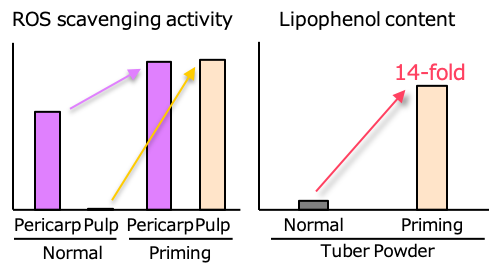
5. Efficacy information
Prevention
・DPPH radical
・Superoxide
・Lipidperoxide
・Hydrogen peroxide
・Melanin production
・Tyrosinase acitivity
・Inflammatory gene expression
・Melanin-related gene expression
・Tumor ※Ref3)
・Aldzheimer ※Ref4)
Expected efficacy
・Antioxidant
・Anti-photoaging
・Anti-inflammation
・Anti-glycation
・Anti-cancer
・Anti-wrinkle/sagging
・Anti-melanogenesis
・Moisture retention
・Intracellular antioxidant
・Anti-dementia
3) B Jayaprakasam et al. J Agric Food Chem. 54 5375-81 (2006)
4) H Kondo et al. Biotechnol Appl Biochem. 61 401-7 (2014)
6. Anti-melanogenic effect of Lipophenol (B16 melanoma cell)
① Melanin production and synthase activity
B16 melanoma cells are cultured for 24 hours. Then add αMSH (melanocyte-stimulating hormone) and Lipophenol-containing DMEM and incubate for 72 hours (use DMSO for negative control and β-arbutin for comparison)
1) After culturing, cell number is measured. Image of solubilized melanin is taken
2) Measure cell viability after culturing. After adding L-DOPA and reacting at 37 ℃ for 60 minutes, measure tyrosinase activity

In αMSH-stimulated B16 cells, Lipophenol suppressed melanin production in a dose-dependent manner. It also suppressed the activity of tyrosinase, an important enzyme for melanin synthesis, and was shown to be more active than arbutin at the same active ingredient concentration.
② Melanin synthesis related genes
B16 melanoma cells are cultured for 24 hours. Thereafter, αMSH and Lipophenol-containing DMEM were added and cultured for 48 hours (DMSO as a negative control, β-Arbutin as a comparative sample). RNA extraction and cDNA synthesis. RT-qPCR using cDNA
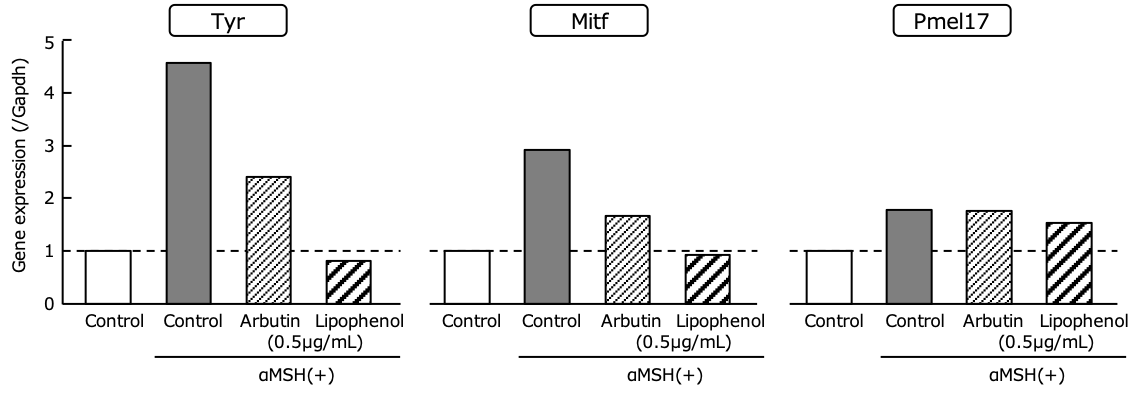
In αMSH-stimulated B16 cells, Lipophenol suppressed the expression of the tyrosinase gene and the transcription factor MITF gene, which were shown to be more active than Arbutin at the same active ingredient concentration. Tyrosinase is the rate-limiting enzyme for melanin synthesis, Mitf is a pigment cell-specific transcription factor and the master regulator of melanocyte development. Also suppressed Pmel17, which is involved in melanin pigmentation

7. Anti-inflammatory effect of Lipophenol (Keratinocyte)
Keratinocytes are cultured for 24 hours. Then, DMEM containing Lipophenol was added and cultured for 48 hours (DMSO as a negative control). RNA extraction and cDNA synthesis. RT-qPCR using cDNA

SCF (Stem cell factor) :
A factor that is produced from epidermal cells by stimuli such as UV rays and activates melanocytes. SCF-stimulated pigment cells synthesize melanin. Excessive production of melanin can cause spots.
IL1A (Interleukin-1α) :
An inflammatory cytokine produced from epidermal cells. The produced IL-1α stimulates pigment cells and promotes melanin production. It increases due to the influence of ultraviolet rays, etc., causing spots formation.
COX2 (Cyclooxygenase-2):
An enzyme used to make prostaglandin E2 (PGE2), an inflammatory cytokine. Under the influence of ultraviolet rays, COX2 increases in epidermal cells and PGE2 is produced excessively. This PGE2 stimulates pigment cells and promotes melanin production.
PAR-2 (Protease-activated receptor-2):
A protein involved in the transfer of melanin from melanocytes to epidermal cells, causing melanin to accumulate in epidermal cells. It increases due to UV rays and inflammation, and if the epidermal cells carry melanin excessively, it can cause spots.
Lipophenol suppressed gene expressions of stem cell growth factor (SCF), cyclooxygenase-2 (COX2), interleukin-1α (IL1A), and protease-activated receptor (PAR2), which encodes inflammation-related proteins in keratinocytes.
Reactive oxygen species (ROS) generated by UV rays put various “gene switches” on epidermal cells, and promote production of inflammatory proteins such as SCF, COX2, and IL1A. UV rays and inflammation also increase PAR2, causing epidermal cells to carry melanin excessively. Lipophenol can be expected to have a anti-melanogenic effects by suppressing these inflammatory factors.
8. Antioxidant properties of Lipophenol
Lipid peroxide inhibition test: Measure conjugated diene formed by oxidation of linoleic acid, Superoxide scavenging test: Measure O2- scavenging ability generated by xanthine oxidase system, Radical scavenging test: Measure DPPH radical elimination ability
H2O2 scavenging test: Measures OH radical scavenging ability generated from hydrogen peroxide
Dose unit: μg/mL
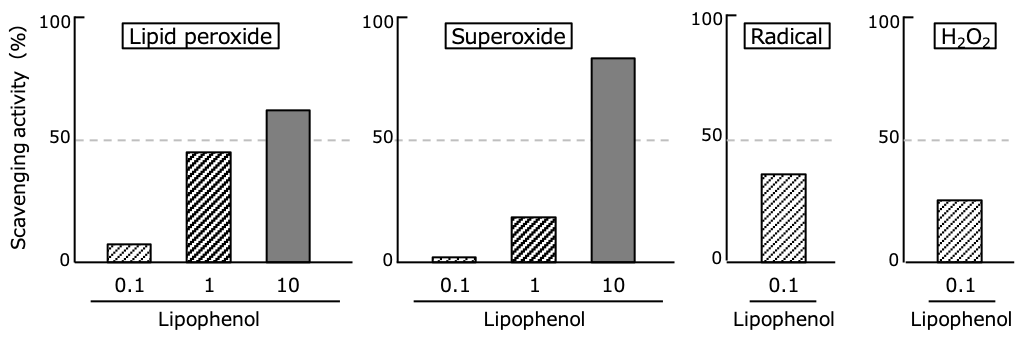
Lipophenol showed a high lipid peroxide inhibitory effect at an active ingredient concentration of 1μg / mL. In addition, radical scavenging activity and hydrogen peroxide scavenging activity were observed at a low concentration of 0.1 μg / mL. Lipophenol penetrates the skin and can be expected to suppress photoaging by eliminating ROS caused by UV exposure. In addition, by suppressing the production of lipid peroxide, it can also be expected to have a anti-pigmentation effect by suppressing the production of perlipidated melanin and normalizing the skin turnover.
9. Hyaluronan production activation effect of Lipophenols (fibroblasts and keratinocytes)
Dermal fibroblasts are cultured for 24 hours. Then add Lipophenol-containing DMEM and incubate for 24 hours (DMSO as a negative control). RNA extraction and cDNA synthesis. RT-qPCR using cDNA
Keratinocytes: as described above
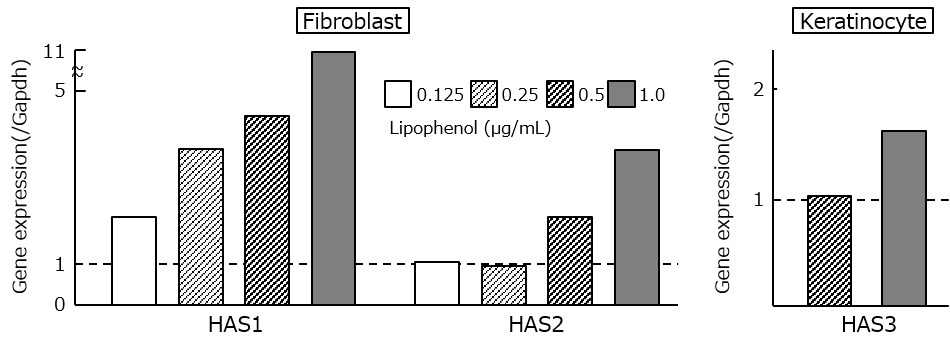
Lipophenol promoted the expression of hyaluronan synthase gene in fibroblasts in a dose-dependent manner. As a result, dermal hyaluronan will be increased, moisture in the dermis is retained, and it can be expected to give the skin firmness and suppress wrinkle formation.
HAS1 and HAS2 produce higher molecule hyaluronan than HAS3 present in the epidermal stem cell membrane. The expression of HAS3, which is responsible for hyaluronan synthesis in the epidermis, was also promoted at a concentration of 0.5 μg / mL or higher. This increases the amount of hyaluronan in the epidermis and maintains the moisturizing function of the stratum corneum.
10. Lipophenol has multiple action points in anti-melanogenesis (summary)
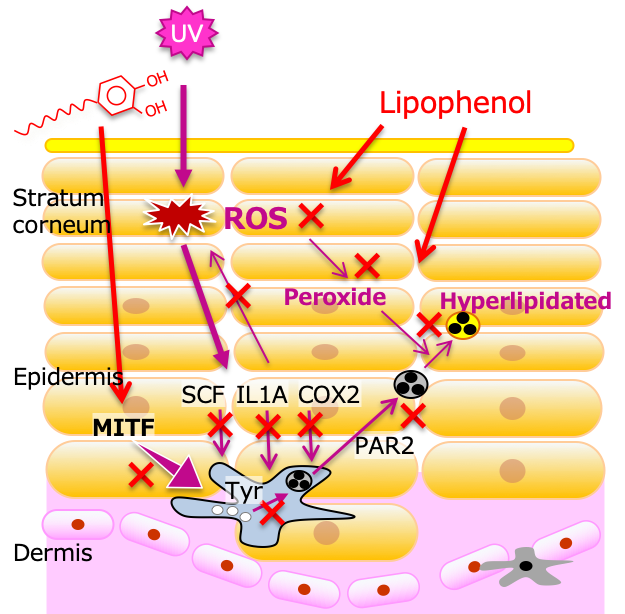 Lipophenol is considered to have multiple action points in anti-melanogenesis.
Lipophenol is considered to have multiple action points in anti-melanogenesis.
(1) Scavenging of ROS, (2) Suppression of ROS production by anti-inflammation, (3) Improvement of skin turnover by prevention of lipid peroxidation, (4) Suppression of hyperlipidated melanin production, (5) Suppression of expression of melanin transport protein PAR2, (6) Suppression of expression of melanocyte-stimulated inflammation-related protein (SCF, IL1A, COX2), (7) Tyrosinase activity and its gene expression suppression, (8) Suppression of expression of melanin synthesis master transcription factor MITF. In some tests, it showed higher activity than arbutin, a major anti-melanogenic ingredient.
In addition, it is known that the transcription factor Nrf2, which regulates the expression of in vivo antioxidant enzymes and detoxification enzymes, is activated by the catechol structure. In other words, it is possible that Lipophenol with a catechol structure suppresses ROS production by activating Nrf2 and enhancing the body’s own oxidative stress suppression mechanism.
These effects are expected to be remarkably expressed due to the high skin permeability of Lipophenol.
11. World's first plant ingredient invented by cosmetic OEM company
Plants and people are very different biologically, and the biocompatibility of plant components is not necessarily high. We have been actively researching how to use plants uniquely and improve the bioavailability of plant components. “Lipophenol” is one of the achievements.
12. Product information
Ingredient information
・Material: Mainly use sweet potato tuber from Ibaraki
・INCI: Ipomoea Batatas Root Extract
・Chinese name:甘薯(IPOMOEA BATATAS)根提取物
・Dosage form:Dissolved in botanical oil
Safety information
・24-hour occlusion patch test: No irritation
・Eye irritation test using SIRC cells: No irritation
・Phototoxicity test by ROS assay: Negative
In principle, the copyright of this document belongs to Saticine Medical Co., Ltd., except where the source is clearly stated. Copying, duplicating, quoting, reprinting, translating, or lending all or part of this document without permission is prohibited, regardless of purpose or method. This document is an ingredient technical document, and the expression introduced in this document does not guarantee that it does not violate various laws.